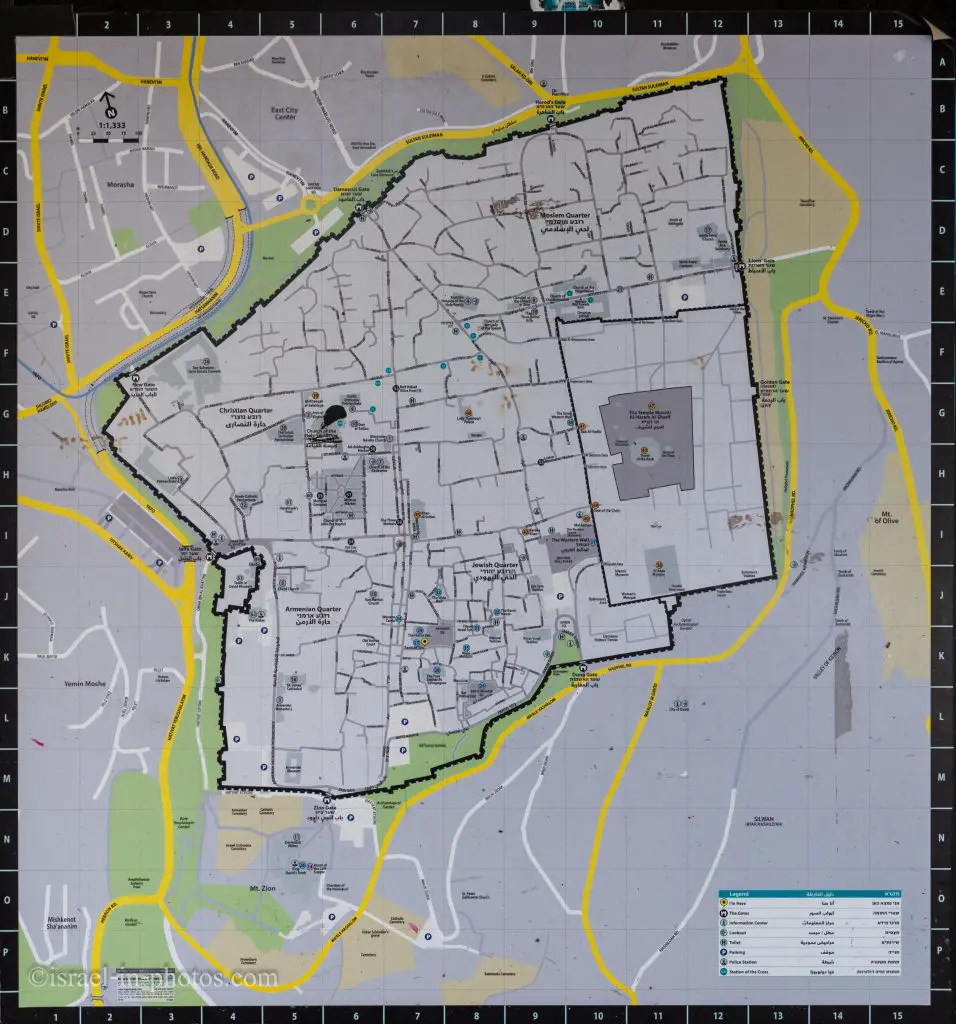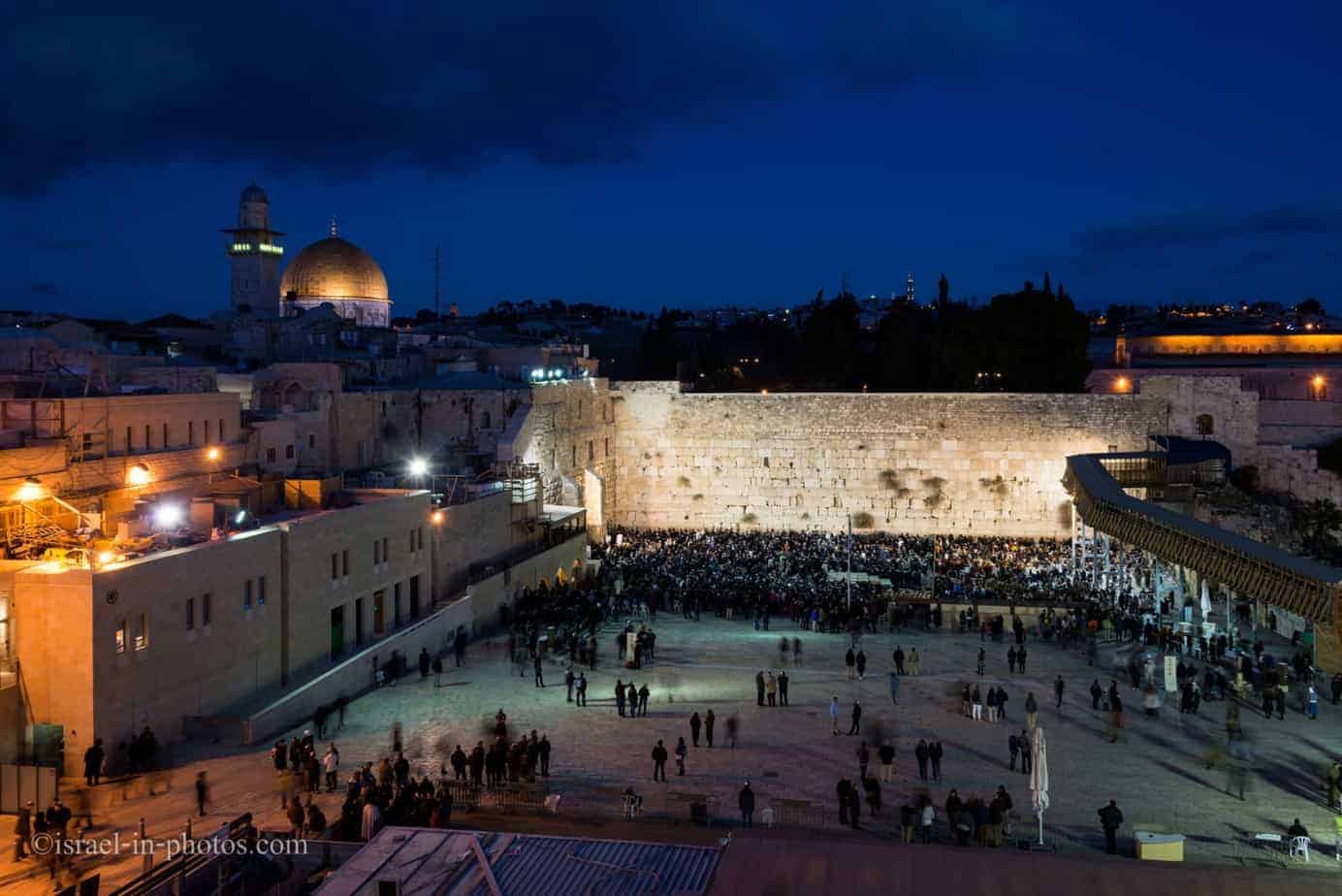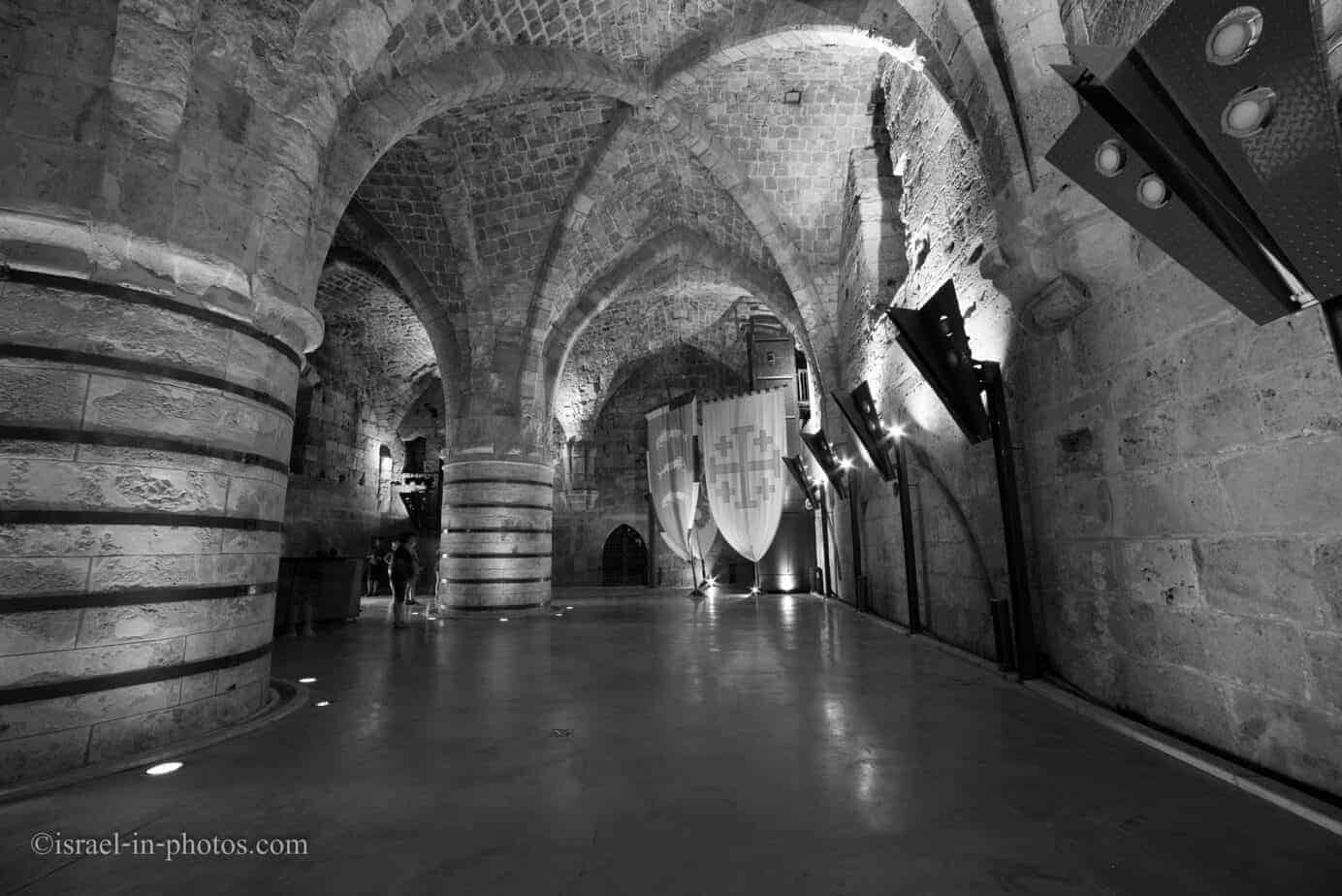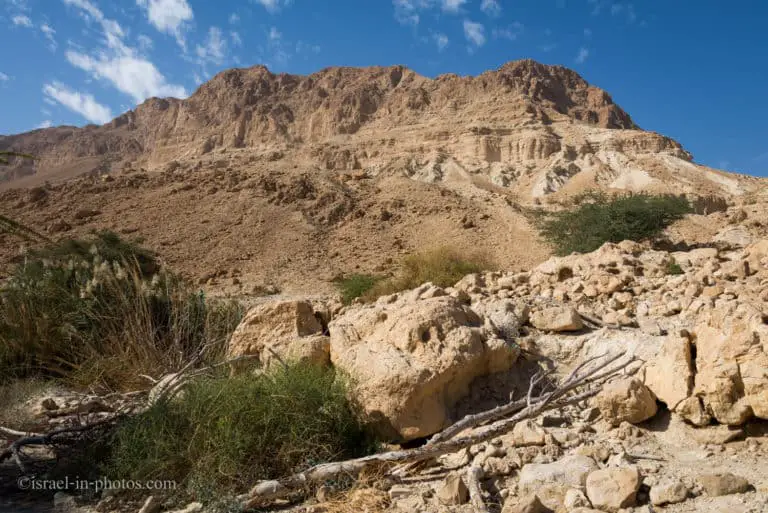Dome of the Rock and The Temple Mount – Travel Guide
Before visiting the Dome of the Rock and The Temple Mount in Jerusalem, this guide will cover everything you need to know.
Table of Contents
Map
Dome Of The Rock and Al-Aqsa Mosque are situated on the Temple Mount within the Old City Of Jerusalem. Dung Gate is the closest one, but you can reach it from any entrance.
Directions for drivers: Link to Waze and Link to Google Maps
Directions for public transport: Link to Moovit
Interactive map of the area:
You can find the following map in several places in the Old City of Jerusalem.
Note: You can click on the map to enlarge it.
On the photo of the map above, the Dome Of The Rock is marked as #43 (square H11). Al-Aqsa Mosque is listed as #38 (square J11), and the Temple Mount is marked as #47 (square G11).
To complete this section, I would like to show an aerial photo. However, as far as I know, you cannot fly drones above the Old City. But you can always take a picture of a model. Here is a photo of the Western Wall and Temple Mount (a model at Mini Israel).
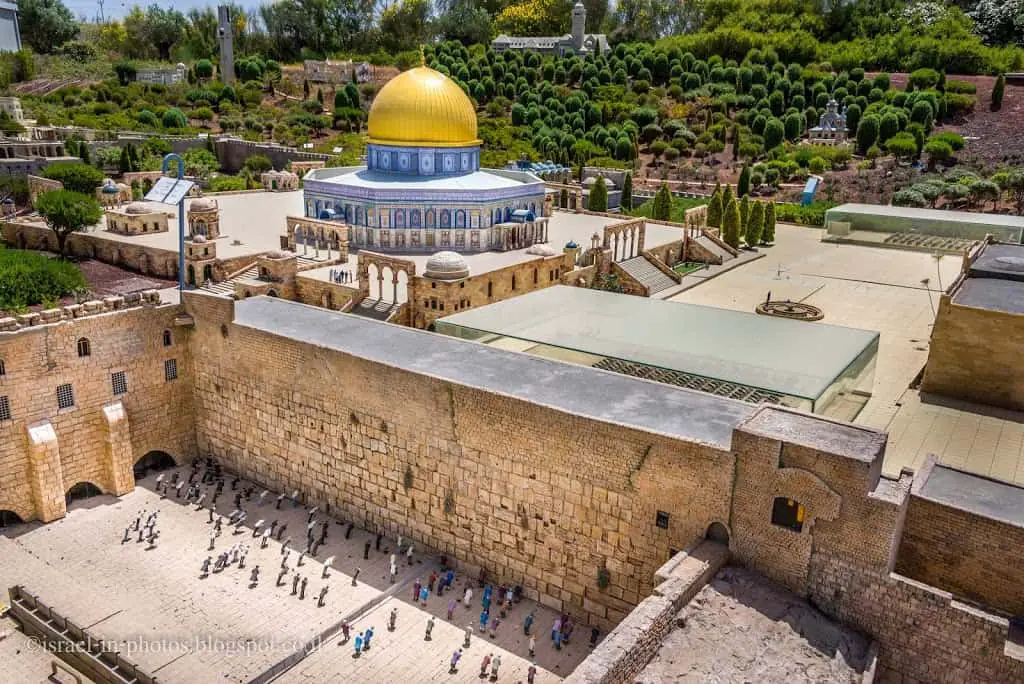
Directions
See the Old City Of Jerusalem for detailed directions on reaching this site.
Temple Mount Entrances
There are eleven entries to the Temple Mount. Muslim prayers can enter through ten of them. But non-Muslims are not allowed to pass there. And for visitors, there is an additional entrance near the Western Wall.
For a more straightforward explanation, let’s use the following aerial photo from Davidson Center.
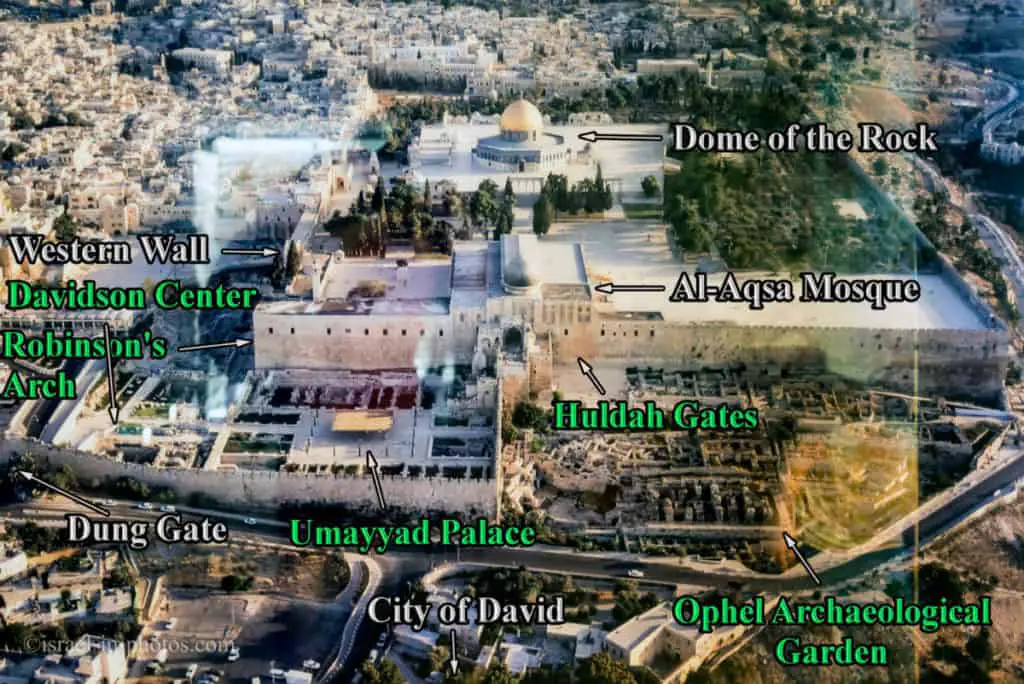
The simplest way to reach the tourist entrance is by entering the Old City through the Dung Gate (lower-left corner in the photo above). Then you continue straight along the fence of Davidson Center until you reach the security checkpoint. There are three entrances at this security point. Two lead to the Western Wall, and the one to the right climbs up to the Temple Mount.
In the following photo of the Western Wall, you can see a bridge to the right. You will be using it to climb the Temple Mount.
Opening Hours
Summer: Sundays – Thursdays: 7:30 – 11:00, 13:30 – 14:30.
Winter: Sundays – Thursdays: 7:00 – 10:30, 12:30 – 13:30.
The Temple Mount is closed to tourists on Fridays and Saturdays.
Notes:
- The opening hours can change due to security limitations. In Jerusalem, you can see the opening on a small electronic display above the entrance. Or you can call +972-2-6226250 in advance and find out about changes.
- The opening hours are pretty limited, and there is a security check at the entrance (you may find yourself waiting in a long line). Thus, I suggest arriving early.
Entrance Fee
Free.
Security Check
The security check is similar to the one you pass in an airport. Before entering, you will pass metal detectors, and your bags will be scanned. Also, the security personnel may request an id. Thus make sure you have your passport with you.
Also, I want to mention that you are not allowed to bring any religious artifacts to the Temple Mount.
Dress Code
The last thing you need to know before visiting is the dress code rules. As with other holy sites, visitors to the Temple Mount are asked to dress modestly. I call it the “knees and shoulders” rule – meaning at least a knee-length dress or trousers. And the shoulders should be covered by a top or a scarf.
Short Overview
The Temple Mount – in Arabic, al-Haram al-Sharif – dominates the Jerusalem skyline. With the Dome of the Rock and the Al-Aqsa Mosque at its center, this rectangular esplanade of some 150,000 square meters occupies one-sixth of the terrain in the Old City. For at least 3000 years, this site has been considered sacred for millions of people worldwide, first by the Jews, later by the Muslims, and Christians also revere it. It inspires research in history, archeology, and culture and incites controversial religious and political sentiments. In Hebrew, it is known as Mount Moriah and Har ha-Bayit (the Temple Mount). In Jewish tradition, it is where Isaac was bound and where Solomon built the First Temple.
After its destruction, the Second Temple was built on this same spot by the Jews who returned from exile, and the Hasmoneans and King Herod later renewed this Temple. Following the destruction in 70 CB, it became the focus of Jewish prayer and longing for reconstruction at the final redemption.
The Prophet Muhammad established Jerusalem as the first direction of Muslim prayer before the Kaaba in Mecca, and the al-Aqsa Mosque is referred to as “the first Qibla” or “the first direction” of prayer. Muslim tradition also maintains that this mosque was the second place of Islamic worship. The Quran mentions the “farthest mosque: to which Muhammad traveled from Mecca to ascend to heaven on his celestial horse. Muslim tradition regards Al Aqsa as this “farthest mosque.” The site is considered the third holiest in Islam, after the Kaaba in Mecca and The Prophet’s Mosque in Medina. Since its construction, it has been an essential Muslim center, except for a short period under the Crusaders (1099-1187). In Arabic, it is known as al-Haram al-Sharif (“the Noble Sanctuary”) or al-Aqsa, a general name for the plaza.
Both Jews and Muslims believe that the Foundation Stone at the center of the Mount is the umbilicus Mundi, the navel of the world, on which the earth rests and from which it expanded. In Christian tradition, the site has historical significance as the site of many events in the life of Jesus of Nazareth and the place where he founded his new religion.
Source: “The Mount” exhibition at the Tower Of David.
On The Temple Mount
Now, after covering the basics, let’s visit Temple Mount. Also, in this section, I want to bring informational extracts.
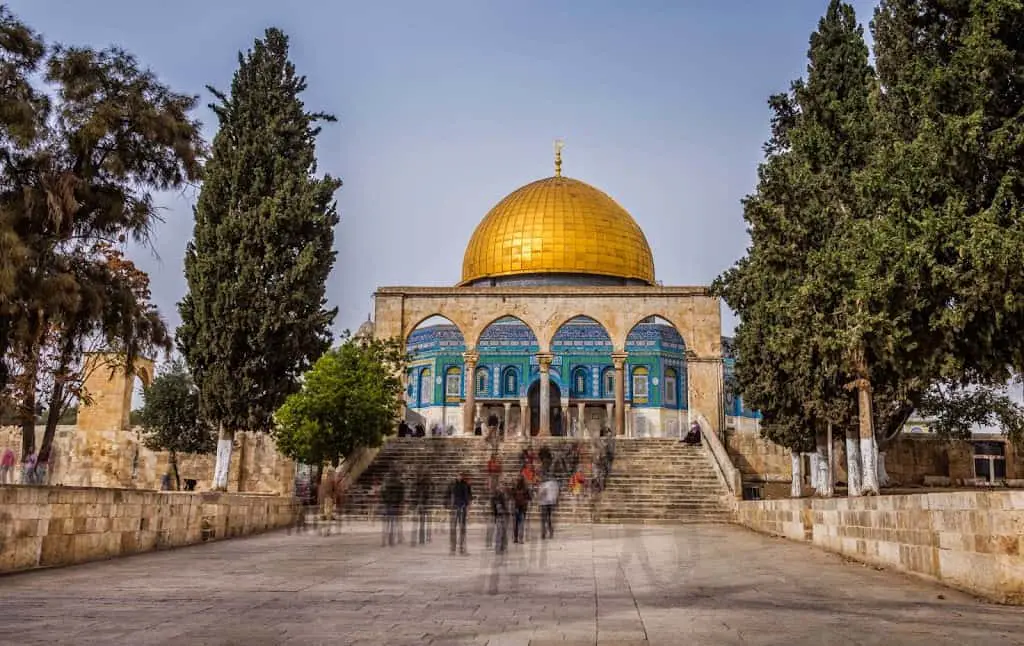
Temple Mount – Description
The Temple Mount (Hebrew: Har HaBáyit, “Mount of the House [of God, i.e., the Temple in Jerusalem]”), known to Muslims as the Haram esh-Sharif (Arabic: al-Ḥaram al-Šarīf, “the Noble Sanctuary”, or al-Ḥaram al-Qudsī al-Šarīf, “the Noble Sanctuary of Jerusalem”) and the Al Aqsa Compound, is a hill located in the Old City of Jerusalem that for thousands of years has been venerated as a holy site in Judaism, Christianity, and Islam alike.
The present site is a flat plaza surrounded by retaining walls (including the Western Wall), which was built during the reign of Herod the Great for an expansion of the Temple. The plaza is dominated by three monumental structures from the early Umayyad period: the al-Aqsa Mosque, the Dome of the Rock, and the Dome of the Chain, as well as four minarets. Herodian walls and gates, with additions from the late Byzantine and early Islamic periods, cut through the flanks of the Mount. Currently, it can be reached through eleven gates, ten reserved for Muslims. One for non-Muslims, with guard posts of Israeli police in the vicinity of each.
According to Jewish tradition and scripture, the First Temple was built by King Solomon, the son of King David, in 957 BCE, and destroyed by the Neo-Babylonian Empire in 586 BCE. However, no substantial archaeological evidence has verified this. The Second Temple was constructed under the auspices of Zerubbabel in 516 BCE and destroyed by the Roman Empire in 70 CE. Jewish tradition maintains that a third and final Temple will also be built here. The location is the holiest site in Judaism and is the place Jews turn towards during prayer. Due to its extreme sanctity, many Jews will not walk on the Mount itself to avoid unintentionally entering the area where the Holy of Holies stood since, according to Rabbinical law, some aspect of the divine presence is still present at the site.
Among Muslims, the Mount is the site of one of the three Sacred Mosques, the holiest sites in Islam. Amongst Sunni Muslims, it is considered the third holiest site in Islam. Revered as the Noble Sanctuary, the location of Muhammad’s journey to Jerusalem and ascent to heaven, the site is also associated with Jewish biblical prophets who are also venerated in Islam. Umayyad Caliphs commissioned the construction of the al-Aqsa Mosque and Dome of the Rock on the site. The Dome was completed in 692 CE, making it one of the oldest existing Islamic structures in the world. The Al Aqsa Mosque rests on the far southern side of the Mount, facing Mecca. The Dome of the Rock currently sits in the middle, occupying or close to the area where the Holy Temple previously stood.
In light of the dual claims of both Judaism and Islam, it is one of the most contested religious sites in the world. Since the Crusades, the Muslim community of Jerusalem has managed the site as a Waqf. The Temple Mount is within the Old City, which Israel has controlled since 1967. After the Six-Day War, Israel handed administration of the site back to the Waqf under Jordanian custodianship while maintaining Israeli security control. It remains a major focal point of the Arab–Israeli conflict. In an attempt to keep the status quo, the Israeli government enforces a controversial ban on prayer by non-Muslims.
Source: Wikipedia
Panorama of the Second Temple Model at Israel Museum:
Herodian Temple Mount and the modern one (shot during Archeological Experience at Tzurim Valley National Park):
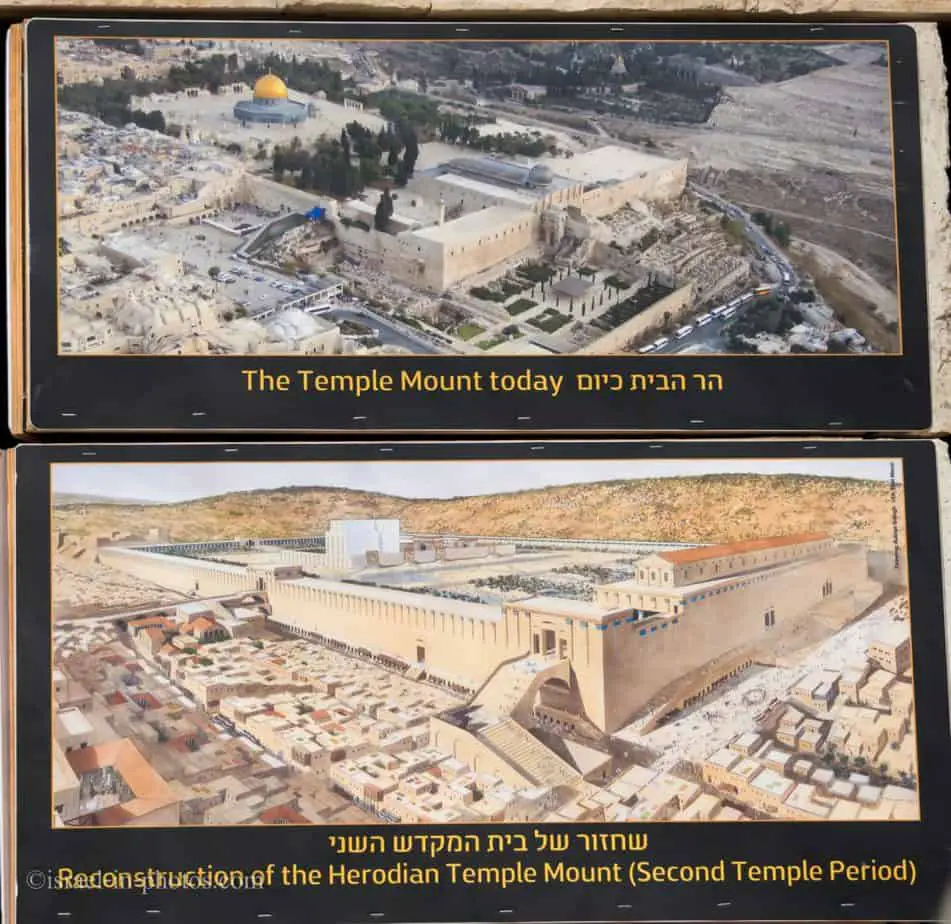
Al-Aqsa Mosque
You enter the Temple Mount in its southern part, near the al-Aqsa Mosque.
The opening hours were adjusted to prayer times. And you will be visiting in between prayers. Nonetheless, during my visit, I saw some people resting and others praying in front of the Al-Aqsa Mosque. I did not feel comfortable photographing them, so here is a photo of the Al-Aqsa Mosque from the Davidson Center.
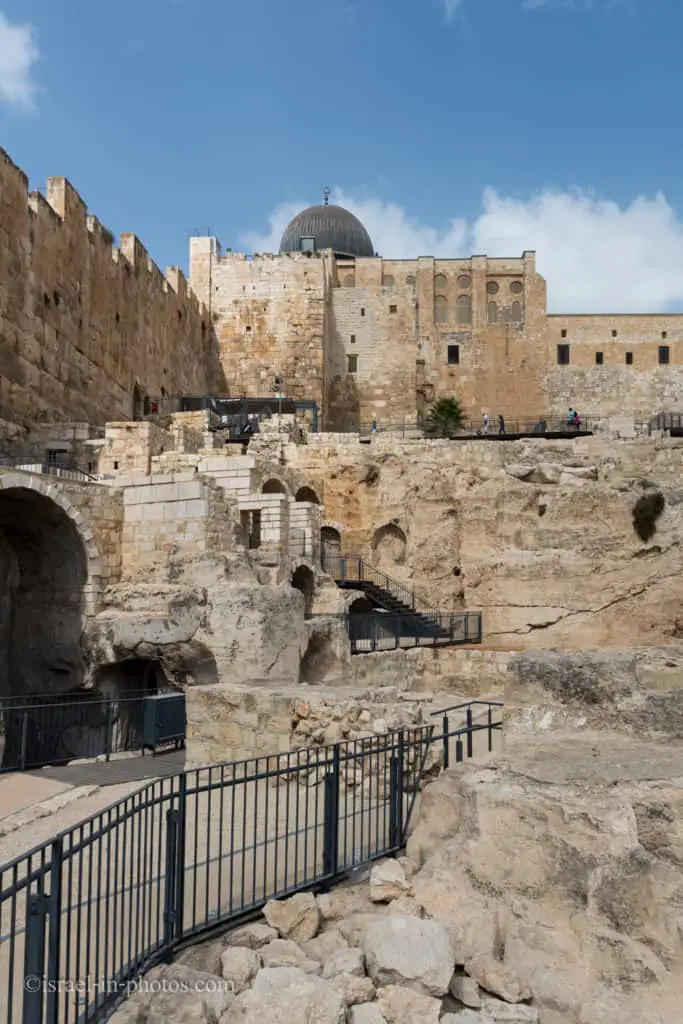
Al-Aqsa Mosque – Description
The Al-Aqsa Mosque (“the Farthest Mosque”), located in the Old City of Jerusalem, is the third holiest site in Islam. The mosque was built on top of the Temple Mount, known as the Al Aqsa Compound or Haram esh-Sharif in Islam. Muslims believe Muhammad was transported from the Great Mosque of Mecca to al-Aqsa during the Night Journey. Islamic tradition holds that Muhammad led prayers towards this site until the 17th month after he migrated from Mecca to Medina, when Allah directed him to turn towards the Kaaba in Mecca.
The covered mosque was originally a small prayer house erected by Umar, the second caliph of the Rashidun Caliphate, but was rebuilt and expanded by the Umayyad caliph Abd al-Malik and finished by his son al-Walid in 705 CE. The mosque was destroyed by an earthquake in 746 and rebuilt by the Abbasid caliph al-Mansur in 754. It was rebuilt again in 780. Another earthquake destroyed most of al-Aqsa in 1033, but two years later, the Fatimid caliph Ali az-Zahir built another mosque whose outline is preserved in the current structure. The mosaics on the arch at the qibla end of the nave also go back to his time.
During the periodic renovations undertaken, the various ruling dynasties of the Islamic Caliphate constructed additions to the mosque and its precincts, such as its Dome, facade, its minbar, minarets, and the interior structure. When the Crusaders captured Jerusalem in 1099, they used the mosque as a palace and the Dome of the Rock as a church, but its function as a mosque was restored after its recapture by Saladin in 1187. The Ayyubids, Mamluks, Ottomans, the Supreme Muslim Council, and Jordan undertook more renovations, repairs, and additions in the later centuries. Today, the Old City is under Israeli control, but the mosque remains under the administration of the Jordanian/Palestinian-led Islamic Waqf.
Source: Wikipedia
Dome of the Rock
I headed towards the Dome of the Rock from the Al-Aqsa Mosque. And here is the al-Kas ablution fountain.
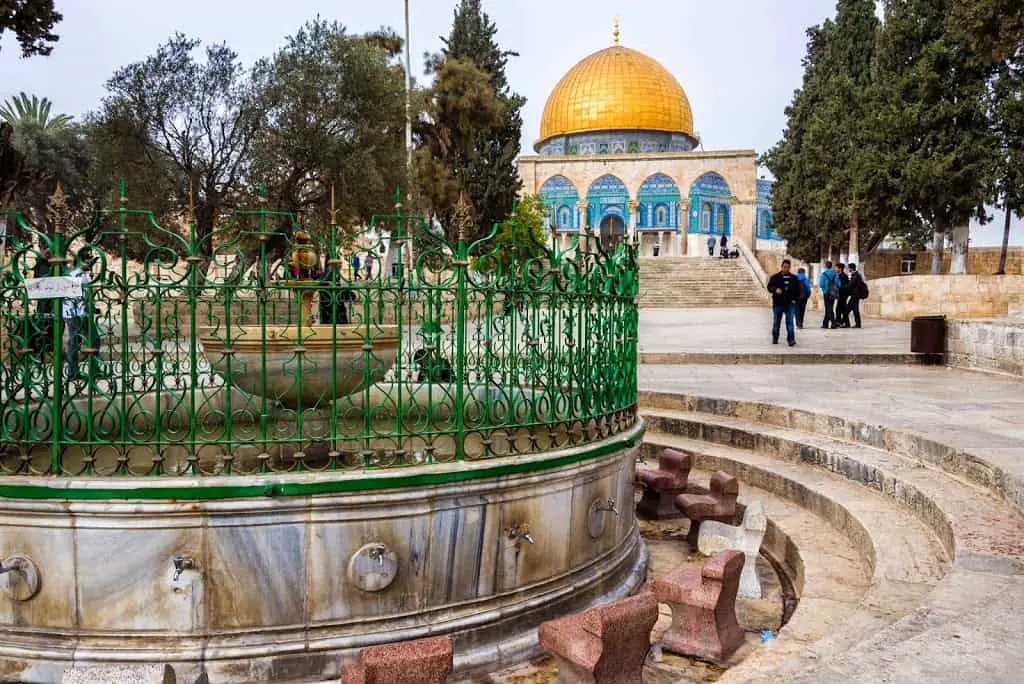
Dome of the Rock – Description
The Dome of the Rock is an Islamic shrine located on the Temple Mount in the Old City of Jerusalem. It was initially completed in 691–92 CE at the order of Umayyad Caliph Abd al-Malik during the Second Fitna on the site of the Second Jewish Temple, destroyed during the Roman Siege of Jerusalem in 70 CE. The original Dome collapsed in 1015 and was rebuilt in 1022–23. At its core, the Dome of the Rock is one of the oldest existing works of Islamic architecture.
Its architecture and mosaics were patterned after nearby Byzantine churches and palaces. However, its outside appearance was significantly changed in the Ottoman period and again in the modern period, notably with the addition of the gold-plated roof, in 1959–61 and again in 1993. The octagonal plan of the structure may have been influenced by the Byzantine Church of the Seat of Mary (also known as Kathisma in Greek and al-Qadismu in Arabic), built between 451 and 458 on the road between Jerusalem and Bethlehem.
The Foundation Stone the Temple was built over bears great significance in the Abrahamic religions as the place where God created the world and the first human, Adam. It is also believed to be where Abraham attempted to sacrifice his son and as the place where God’s divine presence is manifested more than in any other place, towards which Jews turn during prayer. The site’s great significance for Muslims derives from traditions connecting it to the creation of the world and the belief that Muhammad’s Night Journey to heaven started from the rock at the center of the structure.
A UNESCO World Heritage Site, it has been called “Jerusalem’s most recognizable landmark,” along with two nearby Old City structures, the Western Wall and the “Resurrection Rotunda” in the Church of the Holy Sepulchre. It is the earliest archaeologically-attested religious structure built by a Muslim ruler, and the building’s inscriptions contain the earliest epigraphic proclamations of Islam and the Islamic prophet Muhammad. The inscriptions proved to be a milestone, as afterward, they became a common feature in Islamic structures and almost always mention Muhammad.
Source: Wikipedia
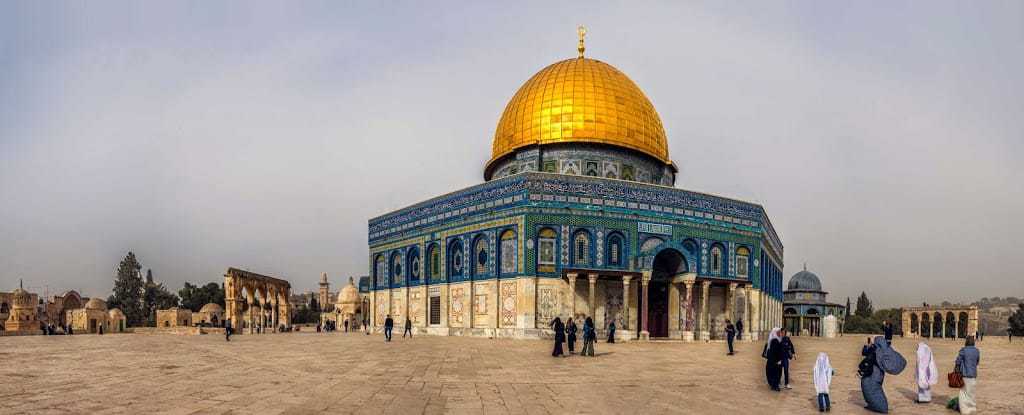
And here is a closeup:
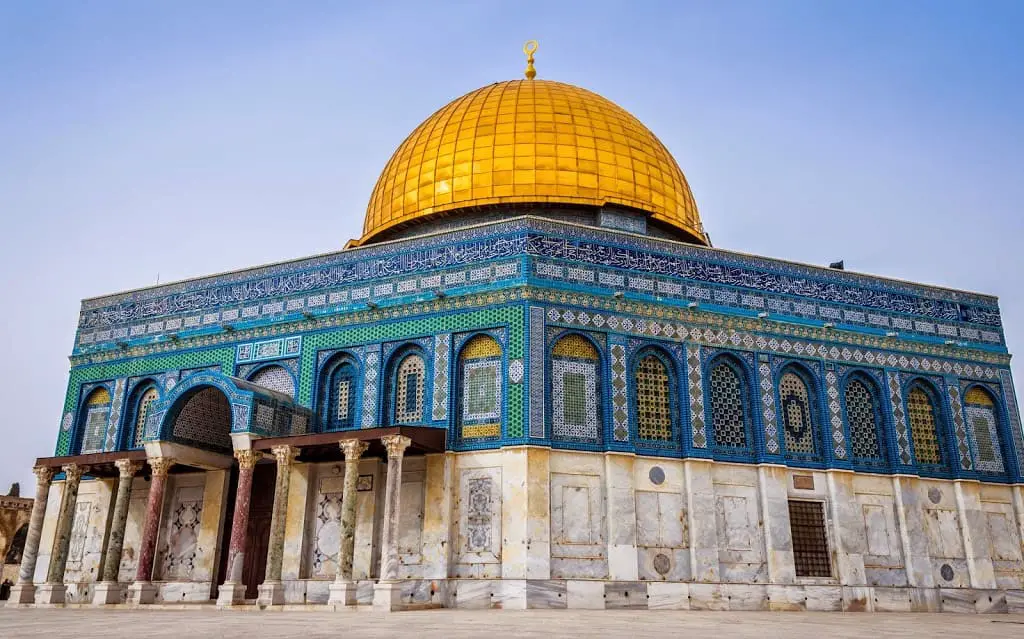
Inside Dome of the Rock
The Dome of the Rock exterior is stunning, but what about the interior? Well. Let’s start with another question.
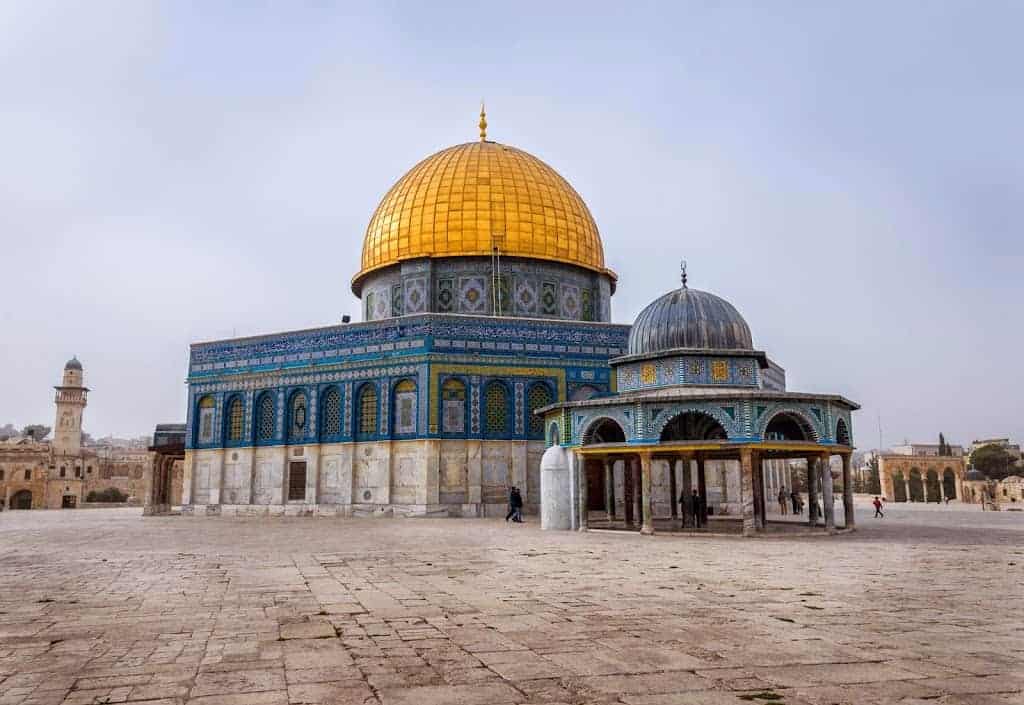
Can you go inside the Dome of the Rock?
No. Non-Muslim visitors cannot enter the Dome of the Rock and the Al-Aqsa Mosque.
I have seen footage of non-Muslim visitors inside the Dome of the Rock. But for that, you need some connections in the Islamic Waqf. And I have none. Thus I was not inside. But I can show several photos of a model I photographed at the Tower Of David.
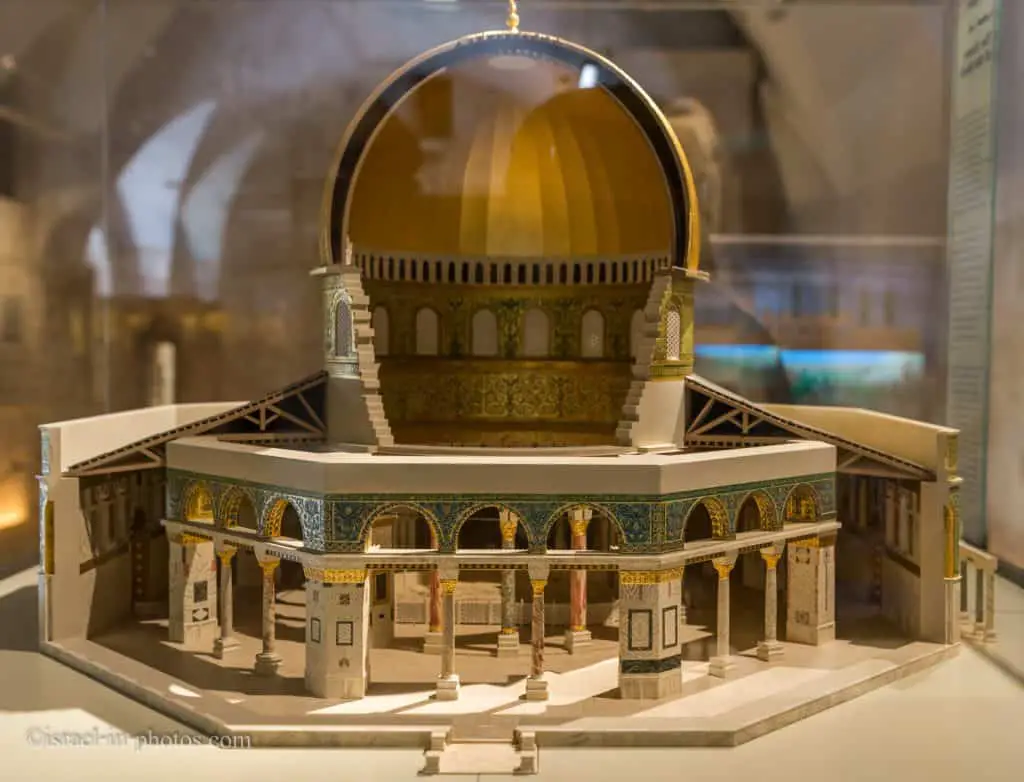
The interior of the Dome is lavishly decorated with mosaic, faience, and marble, much of which was added several centuries after its completion. It also contains Qur’anic inscriptions.
The dedicatory inscription in the Kufic script placed around the Dome contains the date believed to be the year the Dome was first completed, AH 72 (691/2 CE). At the same time, the name of the corresponding caliph and builder of the Dome, al-Malik, was deleted and replaced by the name of Abbasid caliph Al-Ma’mun (r. 813–833), during whose reign renovations took place.
Source: Wikipedia

The Temple Mount and Archaeology
The Temple Mount is an important site, but it never underwent archaeological excavations.
In 1999, the Muslim Waqf began renewal work on the Temple Mount. The renovations were carried out without any archaeological supervision. The building contractors who worked on the Temple Mount dumped the earth and rubble they removed from the site at different trash dumping sites around the city.
As a result, it was decided to carry out extraordinary rescue excavations. And this is how the Temple Mount Sifting Project was born.

We visited Tzurim Valley National Park and participated in the Ancient Jerusalem Sifting Project. We enjoyed the experience, and I am mentioning it since it can be a lovely add-on to this visit.
Note: in the Ancient Jerusalem Sifting Project, we went through rubbles from the City Of David and not Temple Mount. You can find additional information at Tzurim Valley National Park.
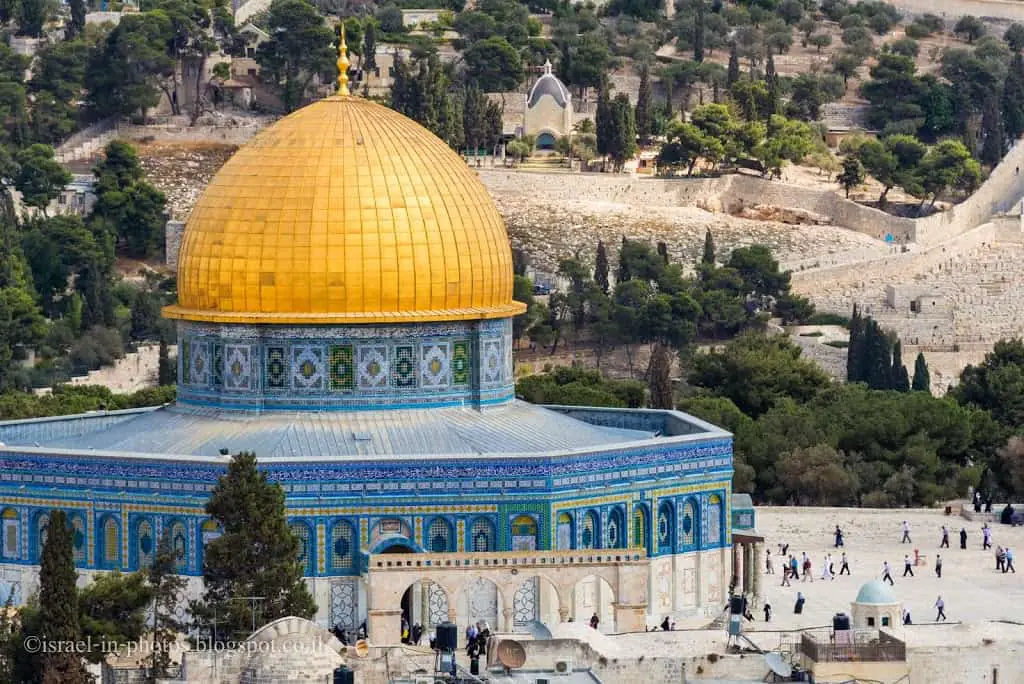
Common Questions
Inside the Dome of the Rock, you can find the Foundation Stone. And the Foundation Stone has tremendous significance in Abrahamic religions. For example, the belief that this is where God created the world and the first human.
Everybody can visit Temple Mount and see the Dome of the Rock exterior. But only Muslims are allowed to enter inside.
Everybody can visit the Temple Mount, but only Muslims can pray there.
Everybody can visit the Temple Mount, but only Muslims can pray there.
Dome of the Rock is an Islamic shrine. You can find the Al-Aqsa Mosque nearby.
Visitors pass through the security checkpoint. Moreover, there are police patrols on the Temple Mount. Thus I felt perfectly safe. And in case of any unrest, the site will be closed to visitors.
No. Non-Muslim visitors cannot enter the Dome of the Rock and the Al-Aqsa Mosque.
Summary
As I mentioned in the guide to the Old City Of Jerusalem, the Dome of the Rock and the Temple Mount are among the most important sites in the city. Thus if you can, I would recommend not skipping it.
Have you ever visited the Dome Of The Rock And The Temple Mount? Tell us about your experience in the comments below.
That’s all for today, and I’ll see you in future travels!
Stay Tuned!
For additional points of interest nearby, check out Jerusalem and the Old City Of Jerusalem. And if you are looking for other places to visit, check out Around The Old City Of Jerusalem.
Additional Resources
Here are several resources that I created to help travelers:- Trip Planner with Attractions and Itineraries is the page that will help you create your perfect travel route.
- What is the Best Time to visit Israel? To answer this question, we will consider the weather, prices, holidays, festivals, and more.
- Information and Tips for Tourists to Israel will answer the most common questions tourists have about Israel (including safety, passports, weather, currency, tipping, electricity, and much more).
- Israel National Parks and Nature Reserves include a complete list, top ten, map, tickets (Israel Pass, Matmon, combo), and campsites.
- If you are looking for things to do, here are the pages for Jerusalem, Tel Aviv, Haifa, Sea Of Galilee, Akko (Acre), Eilat, Nazareth, Safed (Tzfat), and Makhtesh Ramon.

